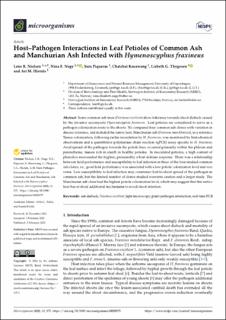| dc.contributor.author | Nielsen, Lene R. | |
| dc.contributor.author | Nagy, Nina Elisabeth | |
| dc.contributor.author | Piqueras, Sara | |
| dc.contributor.author | Kosawang, Chatchai | |
| dc.contributor.author | Thygesen, Lisbeth G. | |
| dc.contributor.author | Hietala, Ari Mikko | |
| dc.date.accessioned | 2022-07-21T09:40:39Z | |
| dc.date.available | 2022-07-21T09:40:39Z | |
| dc.date.created | 2022-05-05T17:32:08Z | |
| dc.date.issued | 2022-02-05 | |
| dc.identifier.citation | Microorganisms. 2022, 10 (2), 1-15. | en_US |
| dc.identifier.issn | 2076-2607 | |
| dc.identifier.uri | https://hdl.handle.net/11250/3007488 | |
| dc.description.abstract | Some common ash trees (Fraxinus excelsior) show tolerance towards shoot dieback caused by the invasive ascomycete Hymenoscyphus fraxineus. Leaf petioles are considered to serve as a pathogen colonization route to the shoots. We compared four common ash clones with variation in disease tolerance, and included the native host, Manchurian ash (Fraxinus mandshurica), as a reference. Tissue colonization, following rachis inoculation by H. fraxineus, was monitored by histochemical observations and a quantitative polymerase chain reaction (qPCR) assay specific to H. fraxineus. Axial spread of the pathogen towards the petiole base occurred primarily within the phloem and parenchyma, tissues rich in starch in healthy petioles. In inoculated petioles, a high content of phenolics surrounded the hyphae, presumably a host defense response. There was a relationship between field performance and susceptibility to leaf infection in three of the four studied common ash clones, i.e., good field performance was associated with a low petiole colonization level and vice versa. Low susceptibility to leaf infection may counteract leaf-to-shoot spread of the pathogen in common ash, but the limited number of clones studied warrants caution and a larger study. The Manchurian ash clone had the highest petiole colonization level, which may suggest that this native host has evolved additional mechanisms to avoid shoot infection. | en_US |
| dc.language.iso | eng | en_US |
| dc.publisher | MDPI, Basel, Switzerland | en_US |
| dc.rights | Navngivelse 4.0 Internasjonal | * |
| dc.rights.uri | http://creativecommons.org/licenses/by/4.0/deed.no | * |
| dc.title | Host−Pathogen Interactions in Leaf Petioles of Common Ash and Manchurian Ash Infected with Hymenoscyphus fraxineus | en_US |
| dc.title.alternative | Host−Pathogen Interactions in Leaf Petioles of Common Ash and Manchurian Ash Infected with Hymenoscyphus fraxineus | en_US |
| dc.type | Peer reviewed | en_US |
| dc.type | Journal article | en_US |
| dc.description.version | publishedVersion | en_US |
| dc.rights.holder | © 2022 by the authors | en_US |
| dc.source.pagenumber | 15 | en_US |
| dc.source.volume | 10 | en_US |
| dc.source.journal | Microorganisms | en_US |
| dc.source.issue | 2 | en_US |
| dc.identifier.doi | 10.3390/microorganisms10020375 | |
| dc.identifier.cristin | 2021925 | |
| dc.source.articlenumber | 375 | en_US |
| cristin.ispublished | true | |
| cristin.fulltext | original | |
| cristin.qualitycode | 1 | |

